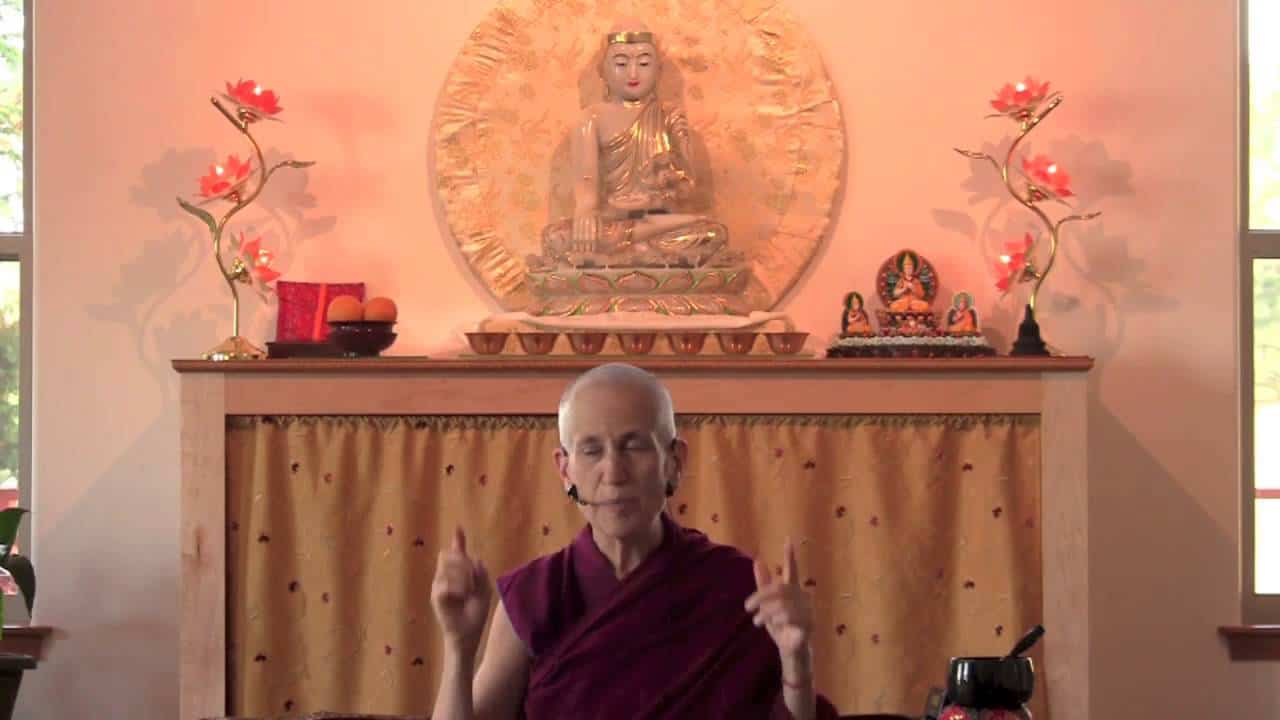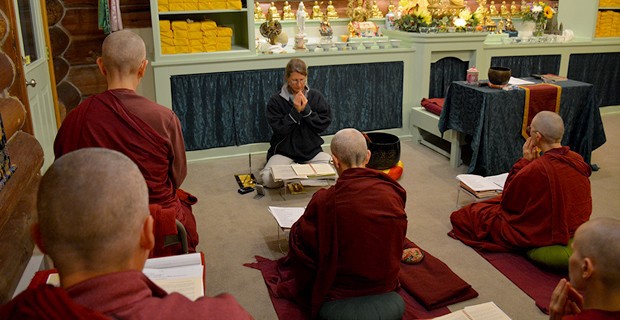How Tara helps us
How Tara helps us
Part of a series of teachings on the text The Essence of a Human Life: Words of Advice for Lay Practitioners by Je Rinpoche (Lama Tsongkhapa).
- Manjushri as Tsongkhapa’s guru
- Taking refuge in Tara
- Understanding and impediments
- Suffering in samsara
- How Tara assists us
- Manifestations of Tara
The Essence of a Human Life: How Tara helps us (download)
Yesterday we started talking about The Essence of a Human Life: Words of Advice for the Lay Practitioners by Je Tsongkhapa. He starts out, the first line is “Homage to my guru the youthful Manjushri.” So he’s paying homage to his guru, because Je Rinpoche, he had direct contact with Manjushri, and the actual Manjushri appeared to him, so he could ask his Dharma questions to Manjushri.
That would be nice, wouldn’t it? Then the only problem is our understanding the answers. But he understood the answers, so that was really good.
The first verse says, “To those….” It’s talking about Tara now, he switches to Tara.
To those within her refuge, every happiness and joy,
for those beset by suffering, every assistance.
Noble Tara, I bow before you.
Here he’s offering praise to Tara. The purpose, at the beginning of texts, of offering praise to one or another of the buddhas is to create merit and to make oneself humble and to indicate that what one is about to say comes from the holy beings. That you’re not making this up yourself. So Je Rinpoche is saying that. So talking about Tara. For those who take refuge in her, who turn to her for spiritual direction, then they receive every happiness and joy. Not because Tara is some independent creator god that fills your stockings up every morning with whatever you want. But because Tara teaches us about karma and teaches about how our mind works, thus empowering us to create the causes for happiness and abandon the causes for suffering. So when we think of the way that the buddhas benefit us, it’s primarily through their speech or their teachings. Because by hearing the teachings, that gives us the power to change our own experience by putting the teachings in practice.
Because the buddhas can’t help us by crawling into our minds and making us think different, or changing the synapses in our brain, or creating the enlightenment pill. Because if the buddhas could have done that, and that would have led us to enlightenment, they would have done that already. There’s no reason not to. But their half of the bargain is they teach, then our half is we have to practice. So that’s where the challenges come. From the side of the Buddha there’s no hesitancy, no impediments to teaching. From our side there are impediments to hearing, even getting to where the teachings are.
We have a slogan here at the Abbey that we never believe somebody’s coming until we see the whites of their eyes in the meditation hall. Not even on the property, because sometimes people will get themselves to the property, and then all of a sudden they go, “Oop! I’ve got to go!” Before even getting in the meditation hall or hearing one teaching. [laughter] So the real thing is to overcome our impediments first, physically to get ourselves where there are the teachings. And then second, to listen attentively instead of spacing out or doodling or falling asleep. And third is remembering the teachings and thinking about them to get a correct understanding. And then practicing them. So these are all steps that we have to do, nobody else can do them for us. We can’t hire somebody else to listen to the teachings and remember them and put them into practice for us. So you could have all the money in the world and all the employees in the world, but it doesn’t do you any good in terms of Dharma practice. Because this is something, like eating and sleeping, that we have to do ourselves. Hiring somebody else to do it doesn’t cut it.
So, “To those within her refuge every happiness and joy,” comes through listening and practicing.
“For those beset by suffering, every assistance.” So if we’re beset by suffering, if we’re experiencing the drawbacks of samsaric existence, which we’re all experiencing, then Tara gives us assistance in overcoming that. So the drawbacks to samsara, they can be described in terms of three. One is just outright pain, physical and mental pain that nobody likes and everybody wants to get rid of. The second one is the unsatisfactoriness of change, meaning that we contact things that give us some pleasure, but that pleasure doesn’t last. Because you would think if it were real pleasure, the more you had contact with the situation or object, the more pleasurable it would be. But that’s not the case. The more we eat, at a certain point, our stomach begins to hurt. The more you’re with the person who you thought was fantastic, 24/7, the more you wish, “Gee it would be nice to talk to somebody else.” So none of these things bring us real happiness in terms of lasting happiness. They’re all kind of dependent, so we’re left frequently dissatisfied. And then the third kind of unsatisfactory condition in samsara is that just our body and mind are under the influence of afflictions and karma. So if you have a body and mind under the afflictions, under the influence of ignorance and afflictions and polluted karma, that’s never going to bring happiness. Because the causes are causes for confusion. They’re causes…. Ignorance and afflictions don’t see things accurately, so they’re not going to bring a good result.
Just being in that state means that even when we’re not experiencing gross pain or something, we’re kind of on the edge of the cliff all the time, you know? Because any small change in our circumstances and wham, our whole feeling of happiness instantly changes.
If we’re in that kind of situation—which all samsaric beings are in—then Tara offers us every assistance. And again, the way she offers assistance is by teaching us what to practice and what to abandon, in other words, the law of karma and its effects. She teaches us bodhicitta. She teaches us the wisdom realizing emptiness. And by practicing those, by practicing love and compassion, bodhicitta, we get along much better with others, we’re more peaceful inside ourselves. By gaining the wisdom understanding emptiness, then we cease all of these afflictive, crazy mental states, all these impulses that pop into our mind that are not well thought out, that we think are going to bring us happiness but just create one mess or the other. So we start to cease those things. So it’s through Tara’s guidance and teachings that we become empowered to create the causes of happiness, abandon the causes of suffering, both temporal happiness and suffering and ultimate happiness and suffering.
In that way, that’s how Tara guides us, and so that’s how all the buddhas guide us, and so Je Rinpoche here is paying homage to someone who can do that, which is fantastic. I mean, isn’t it wonderful that there are beings in this universe who can do that. If there were nobody who could teach us about karma, and nobody who could teach us about the essence of reality, then we’d be really sunk. But having these buddhas who can really guide us gives us a lot of hope and optimism.
[In response to audience] What’s the difference between all the Taras? Well, they look different. That’s one thing. But that’s an outside, superficial difference. In terms of what they understand, they all understand the same things. They all have the same good qualities. So there’s no difference in that way. But the way they help us can be a little bit different, because they each have their specialty in how they help us. So some Taras clear away interferences. Some Taras cause long life. Some Taras help us to be joyful with other living beings. So they all have different specialties like this.
Although actually, they can all do the same thing. [laughter] But they just look like they have different specialties.
Venerable Thubten Chodron
Venerable Chodron emphasizes the practical application of Buddha’s teachings in our daily lives and is especially skilled at explaining them in ways easily understood and practiced by Westerners. She is well known for her warm, humorous, and lucid teachings. She was ordained as a Buddhist nun in 1977 by Kyabje Ling Rinpoche in Dharamsala, India, and in 1986 she received bhikshuni (full) ordination in Taiwan. Read her full bio.


